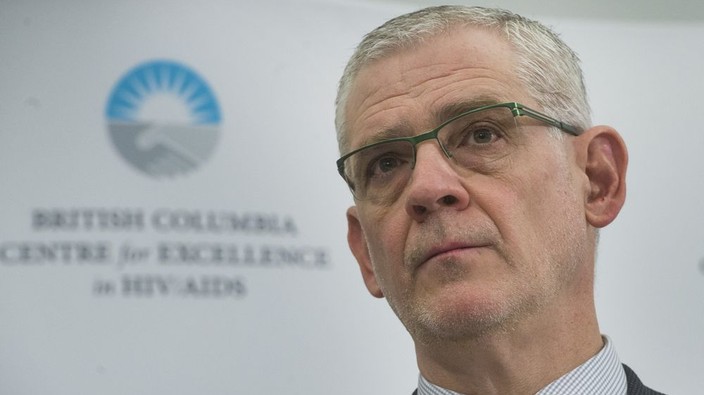opinion: canada must recommit to hiv/aid targets
as of the end of 2020, most of the world had failed to meet the un 90-90-90 target.

dr. julio montaner is director of the b.c. centre for excellence in hiv/aids, canada’s largest hiv research organization, and is a professor of medicine at the university of b.c.
arlen redekop
/
png
by: dr. julio montaner june 5 marked 40 years since the u.s. centers for disease control and prevention first described cases of what came to be known as aids. since then, unaids estimates nearly 33 million people have died from hiv/aids, and about 38 million people currently live with hiv.
millions of those deaths and infections could have been prevented because we have had the tools and medicines to control hiv/aids since 1996, when we introduced highly active antiretroviral therapy (haart) at the 11th international aids conference in vancouver. haart stops hiv replication, thus restoring health and preventing progression to aids and premature death. at the same time, haart renders hiv undetectable in biological fluids, which in turn renders hiv untransmissible; in other words, haart stops hiv transmission. these findings led us to propose the expansion of haart to all hiv-infected individuals under the treatment as prevention (tasp) banner in a landmark lancet article in 2010, and b.c. led the world in implementing tasp.
in 2014, working with the united nations joint aids program (unaids), the b.c.-centre for excellence in hiv/aids (bc-cfe) developed the tasp-inspired 90-90-90 target, designed to “end aids as a pandemic by 2030” — defined as decreasing aids-related mortality and hiv new infections globally by 90 per cent using 2010 as the baseline. the goal was to ensure at least 90 per cent of people living with hiv were diagnosed, at least 90 per cent of those diagnosed were on haart, and at least 90 per cent of those on haart had undetectable hiv levels by the end of 2020. in 2015, the target was formally adopted by the united nations and canada, and became known as the un 90-90-90 target.
advertisement
on the most recent world aids day (dec. 1, 2020) the bc-cfe was proud to announce, alongside b.c.’s minister of health adrian dix, that b.c. had surpassed the 90-90-90 target, with 92 per cent of people living with hiv in b.c. diagnosed, 91 per cent of them on haart, and 95 per cent virally suppressed. as a result, b.c. has seen a decrease in aids-related morbidity and mortality of over 90 per cent and a decrease in new hiv infections by over 85 per cent. these findings provide irrefutable proof that the tasp strategy works.
however, as of the end of 2020, most of the world had failed to meet the un 90-90-90 target. unaids estimates that failure to meet the un 90-90-90 target globally by 2020 led to an additional one million aids-related deaths, and three million new hiv infections. while we don’t yet fully know the extent to which covid-19 has worsened the situation, preliminary reports are concerning, as covid-19 has had direct impact on the lives of people living with hiv and their access to life-saving health programs.
failing to meet the un 90-90-90 target by 2020 created significant anxiety in the hiv/aids field. although not widely recognized, our original plan called for the un 90-90-90 target to become the un 95-95-95 target at the end of 2020. under the new un 95-95-95 target, the number of people newly infected with hiv would fall from 1.7 million in 2019 to 370,000 by 2025, and the number of people dying from aids-related illnesses would be reduced from 690,000 in 2019 to 250,000 in 2025.
advertisement
this week, the united nations general assembly convened a high-level meeting on aids. ending aids as a public health threat by 2030 remains possible. on june 8, under the leadership of un secretary general antónio gutteres, un members states, including canada, agreed to endorse the un 95-95-95 target. we applaud the secretary general’s call to action, and the global community for rallying behind it.
however, we have learned from years of unmet promises and unfulfilled political declarations. words are nice, but delivering on our commitments is what really matters. we urge the canadian federal government to lead by example and redouble the financial contribution to support the made-in-canada un 95-95-95 target, and to use the upcoming g7 meeting to mobilize the richest world economic powers to jointly lead the refinancing of this important effort to end the public health threat of hiv/aids.
dr. julio montaner is director of the b.c. centre for excellence in hiv/aids, canada’s largest hiv research organization, and is a professor of medicine at the university of b.c.
letters to the editor should be sent to sunletters@vancouversun.com. the editorial pages editor is hardip johal, who can be reached at hjohal@postmedia.com.
click here to report a typo.
is there more to this story? we’d like to hear from you about this or any other stories you think we should know about. email vantips@postmedia.com.
 3 minute read
3 minute read
